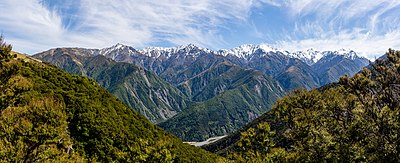Kaikōura Ranges
The Kaikōura Ranges are two parallel ranges of mountains located in the northeast of the South Island of New Zealand. The two ranges are visible from a great distance, including from the southern coast of the North Island.

Description
Formed along New Zealand's Marlborough Fault System, they can be seen as the northernmost extension of the Southern Alps in the South Island. Named the Looker-on mountains, by Captain James Cook, they take their name from the town of Kaikoura at the southern extreme of the more eastern range, the Seaward Kaikōuras. This range rises straight from (and dominates) the coast to the north of the town, and reaches its highest point with the 2,608-metre (8,556 ft) Mount Manakau.
The long straight river valley of the Clarence River separate the Seaward Kaikouras from the longer and loftier Inland Kaikōuras. This latter range contains the highest peak in the ranges, the 2,885-metre (9,465 ft) Tapuae-o-Uenuku, the translation from the Maori of which is the poetic "Footprint of the rainbow". Beyond the Inland Kaikōuras is the valley of the Awatere River, which runs parallel to that of the Clarence. The climate is characterised by a dry cold winter.
Flora
These mountains are characterised by tussock land, fellfields, and large areas of open scree, while lowland forests have largely been cleared. The Spencer range to the south meanwhile has a more intact beech forest covering.[1]
Fauna
The ranges contain the Kowhai Valley and Shearwater Stream Important Bird Area.[2]
References
- "Northern part of New Zealand's South Island – Ecoregions – WWF". World Wildlife Fund.
- BirdLife International. (2012). Important Bird Areas factsheet: Kowhai Valley, Shearwater Stream. Downloaded from http://www.birdlife.org on 2012-02-18.